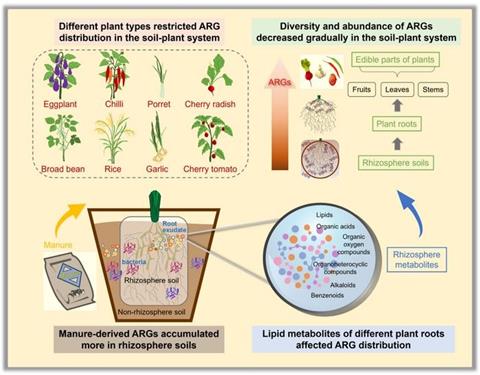Antibiotic resistance is one of the most pressing global health challenges, and farms that use livestock manure as fertilizer have emerged as important sources of resistant bacteria and genes in the environment.

A new study published in Agricultural Ecology and Environment shows that the chemistry of crop roots plays a decisive role in how antibiotic resistance genes (ARGs) move from soil to plants.
READ MORE: Researchers develop innovative solution for tracking antibiotic resistance genes
Researchers from the Agro-Environmental Protection Institute, Ministry of Agriculture and Rural Affairs, found that the rhizosphere, the narrow soil zone surrounding plant roots, is a major hotspot for the accumulation of manure-derived ARGs. Across eight common crops, ARG abundance in rhizosphere soil was on average 1.24 times higher than in bulk soil. Yet the transfer of these genes into plant tissues varied dramatically among crop types.
Leafy vegetables such as porret (chives) and broad beans accumulated far more ARGs in their edible parts than fruit-bearing plants like cherry tomato and rice. In some leafy crops, the abundance of multidrug resistance genes was nearly ten times higher than in fruit crops, suggesting that what farmers grow can influence the potential risk of antibiotic resistance entering the food chain.
Surprising driver
The study also uncovered a surprising driver behind these differences. By combining high-throughput gene analysis with untargeted metabolomics, the team identified root-derived lipid metabolites as key regulators of ARG transmission. Certain lipids, including phosphatidic acid and phosphatidylserine compounds, appeared to shape microbial communities in the rhizosphere and promote the persistence of resistance genes.
In addition, the researchers found that a mobile genetic element called cIntI-1(clinic) strongly correlated with ARG abundance in both roots and edible tissues, indicating that it may facilitate the transfer of resistance within plants.

“These findings show that the root chemistry of crops can determine how antibiotic resistance moves through soil and plants,” said corresponding author Dr. Fengxia Yang. “Understanding these processes can help guide crop selection and soil management practices to reduce resistance risks in agriculture.”
The authors suggest that identifying and managing plant metabolites that drive resistance spread could be an effective strategy to limit the movement of ARGs from farm soils into the human food chain.
Topics
- Agriculture
- Agro-Environmental Protection Institute
- Antimicrobial Resistance
- Asia & Oceania
- broad beans
- chives
- Fengxia Yang
- food chain
- Food Security
- Guizhou University
- Healthy Land
- Linyi University
- manure-derived ARGs
- National Observation and Research Station
- One Health
- porret
- Research News
- rhizosphere
- root-derived lipid metabolites
- Shenyang Agricultural University
- Soil & Plant Science







No comments yet